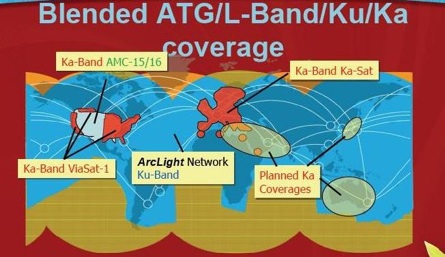As airline passenger demand for greater bandwidth grows in the coming years, ViaSat sees Ka-band-based in-flight connectivity playing an important role in supporting these services.
"It's all about the bandwidth. You have to have the bandwidth to support high-speed [connectivity] on a cheap cost per bit and have lots of bits," says ViaSat strategy director Bill Sullivan.
ViaSat is initially focused on developing a global Ku-band mobile broadband network for airlines, the business aviation community, the maritime market and others. But while "Ku is a good first step, we think Ka is a great next step," says Sullivan.
Eutelsat will launch its Ka satellite in 2010 "and we're providing the ground segment for that with all the hooks for mobility", says Sullivan, and then in early 2011, ViaSat's own Ka satellite is expected to launch.

With this capacity, ViaSat is looking at hybrid solutions for aircraft operators that take advantage of Ku-, Ka- and L-band, where it makes sense, says Sullivan, who also acknowledges that air-to-ground (ATG) connectivity - the likes of which is offered by Aircell in North America - could also augment the offering.
"Now that Aircell has built out the system, the bandwidth is pretty cheap and it has reasonable speeds and passengers today are getting good quality service," notes Sullivan.
ViaSat is not the only firm keeping a close eye on Ka-band for in-flight connectivity.
JetBlue Airways subsidiary LiveTV remains on the fence about the role that Ku-band will play. However, it is looking at Ka-band and believes that "this network will finally deliver the cost and speed that is sustainable for a broadband service in the future", LiveTV VP of marketing and sales Mike Moeller recently told ATI and Flight Global.
Source: Air Transport Intelligence news



















